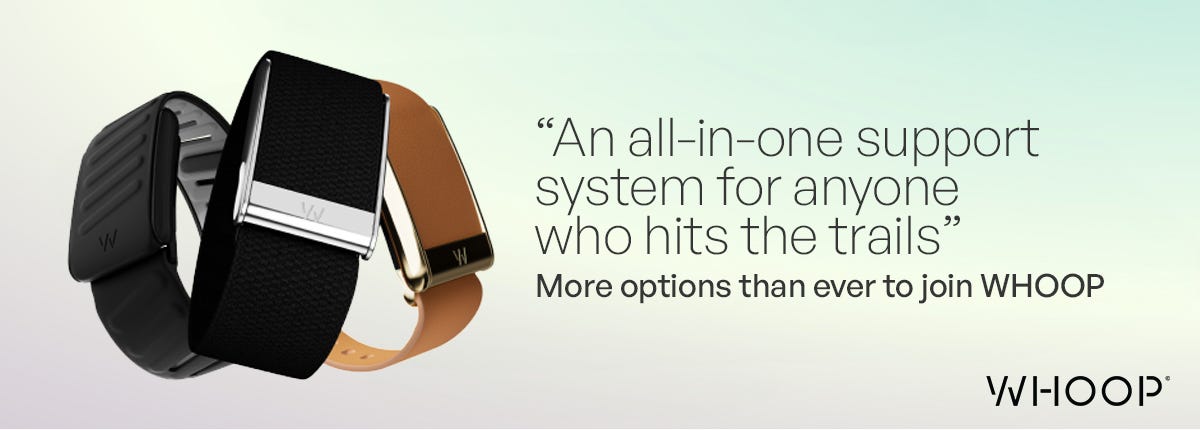9 tips for staying safe on a hike
Whether you're a new or experienced hiker, these tips will keep you safe, happy, and healthy on the trail
This issue is sponsored by WHOOP, my constant hiking companion. Checking my recovery stats before a hike has saved me from over-exerting myself on trails more than once. Journaling my behaviors has helped me dial in the most effective recovery practices for me, so I can hit the next trail feeling refreshed. Tracking my activity via the Strava connection gives me all the details I could want on distance, elevation gain, and pacing. It’s an all-in-one support system for anyone who hits the trails. Click here to learn more, pick the plan that works for you, and get your first month of WHOOP free.
I am an experienced solo hiker. I’ve hiked alone in more than a few countries, and take extended trips throughout the U.S. to hike by myself every year. Part of the reason I’m successful in my ventures is because I follow these safety tips everywhere I go. Even on trail runs in my backyard. Even on short hikes that I know will be peppered with families. It’s become habit at this point, and these habits has saved my butt more than once.
If you’re an experienced hiker too, use this as a refresher. If you’re new to hiking, these tips will help you have more fun and more success on the trail. (And if this list looks intimidating, I promise, it will become second nature in no time.)
1. Know the trail before you go
Someone asking, “Am I close?” when they are not even close to close is concerning. I really want you to know how long and hard the trail is, so you can properly prepare. Review and download the trail in AllTrails ahead of time. (Get a Pro subscription—it’s worth it.) Is it a loop or an out-and-back? What’s the distance and elevation gain? What is the trail rating? Where is the gain—all in one place, or spread throughout the hike? Are there water crossings or rock scrambles? Also, read recent trail reviews for important facts, like bugs, no shade, or leftover snowfields.
If the hike is in an unfamiliar area, Google the trail and see if anyone has blogged about it. Often you’ll get far more detailed trail markers and directions (with photos, even) from a personal blog.
2. Check your trail map as you hike
Downloading the map lets you see where you are on the trail even without cell coverage. If the trail is new or unfamiliar, check your map often to ensure you’re still on route. This is especially important if there isn’t a real “trail,” just markers (like hiking across rocks), or water crossings where the path isn’t obvious. If you get into a sketchy spot and think, “There has to be a safer way than this,” there probably is. Check your map on the way back, too! I can’t tell you how many times the trail looked obvious on the way out, but less obvious on the way back—and I got off-route as a result.
3. Stay on the trail
It’s tempting to go off-trail to see what’s beyond those rocks or get closer to the falls. But going off-trail is both unsafe and environmentally irresponsible. It’s easy to get lost if you wander too far off-trail, especially in a heavily forested area. It can also be dangerous, if you encounter a steep drop-off, slippery rocks, or rushing water. Finally, staying on the trail helps protect the natural environment for other hikers to enjoy.
4. Check the weather before you go
See if the area is prone to afternoon thunderstorms, or if the trail features big winds at the summit or zero shade. Look at the weather in the area you’ll be hiking, not the place you’re starting from. (There can be a 20+ degree temperature swing between the valley and the peaks.) If the weather looks dicey later in the day, find a shorter trail or designate a hard-and-fast turnaround time so you’re not caught in a storm. If it’s going to be super sunny with a high UV index, prepare for that sun exposure.
5. Over-prepare
I know there’s a meme about your kid hiking this trail in Crocs, but being prepared is cool. Bring more water (with electrolytes) than you think you need, and leave a fresh bottle in the car. Bring more snacks than you think you need. Bring a layer or two, and make sure one is wind and rain resistant. If you’re hiking in a sunny area (like the desert) bring a sun hoodie with UPF protection, and a hat. A small bottle of bug spray and sunscreen live permanently in my pack, as do band-aids, spare contact lenses, matches, a head lamp, and a bandana. These things are small, light, and could be necessary if things go sideways. And please, wear appropriate shoes. (Hint: not Crocs, not even in Sport Mode.) Leaving a fresh pair of socks and shoes or sandals in the car is also highly encouraged.
You may not need the extra water, snacks, or bug spray, but someone else on the trail might. I’ve been a “trail angel” more than once, and it feels good to help someone stay healthy and happy on their hike.
6. Carry emergency gear
If you only pay attention to one thing, let it be this: You cannot count on cell phone service. If you’re an avid hiker, especially if you hike alone, a satellite communicator is a must. My Garmin InReach was $400, with a small subscription fee for 2-way communications. It also includes an SOS button in case you need search and rescue. (I also pay $40 a year for Search and Rescue insurance. If I ever have to push that SOS button, it’ll cover up to $100K in SAR fees (like a helicopter and medical treatment). This may be overkill if you’re just exploring your neighborhood foothill trails, but many of my trails take me miles into the middle of nowhere, often on tricky terrain. An InReach also doubles as 2-way comms on road trips or while camping in areas without service.
7. Be animal-aware
Know what animals you are likely to encounter in your hiking area. It’s not just bears—you may find moose, deer, elk, mountain goats, sheep, rattlesnakes, and even mountain lions. (Moose can be especially nasty, especially in rutting season.) Hike aware, making noise if you’re alone. Carry bear spray if needed, and know how to use it. Know what to do if you encounter an animal on the trail.
I highly recommend hiking without headphones for this reason (and others). You often hear large animals before you see them, and you’ll want as much advanced notice as possible to stay safe.
8. Be man-aware
I’m more afraid of being assaulted on a trail than I am being attacked by a bear. If you’re hiking alone, trust your gut. I’d rather a man think I’m an a**hole than override my instincts and get hurt. If you feel at all uncomfortable, pull out your phone, start recording (or place a call if you have service), and head back down, or wait for another person or group and tag along. (This is another reason why I never hike with headphones.) Carry pepper spray or bear spray, and know how to use it. A small personal alarm can be helpful here too. I also count cigarette smoke on the trail as a warning sign. Generally speaking, someone smoking a mile up the trail isn’t there for the same reasons you are.
9. Know your limits
It’s hard to turn around if you’ve set a goal to reach the summit. Still, accidents happen when you’re tired, hurt, thirsty, hot, at unfamiliar altitude, and/or overestimate your abilities. If the scramble looks sketchy, either wait and see how others attempt it, or decide you’ve come far enough. If you’ve got a headache and feel kind of sick, head back down to a lower altitude. If the water crossing looks far more aggressive than you imagined, see if there is another way across, or end your hike there. If you’re in snow up to your knees without poles or snowshoes, come back in a few weeks. If you see storm clouds rolling in, immediately head lower.
This goes for your pacing too! Trying to keep up with someone faster than you is a recipe for exhaustion, and potentially a fall. Don’t be too proud to ask your group to slow down, or (if you feel comfortable) let them go ahead and pick a meeting spot so you can hike at a comfortable pace.
Stay safe and enjoy “church”
Hiking, especially alone, can be such a restorative and empowering experience. Taking these steps to stay safe can help you feel more confident on the trail. What other tips do you have for hiking safety? Share them in comments.





Thank you! I have honestly been afraid to try hiking alone, which means I go on a lot fewer hikes than I would like. I appreciate the practical tips. Now I’m inspired!
This is amazing information! Thank you for sharing! ❤️